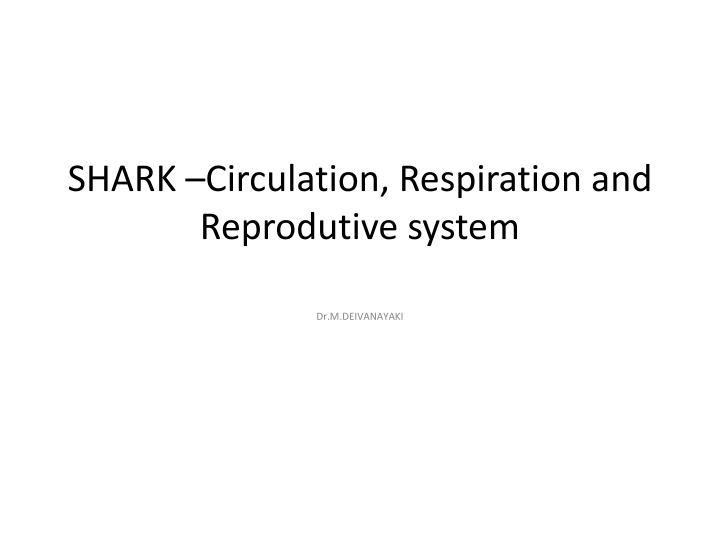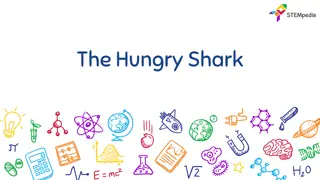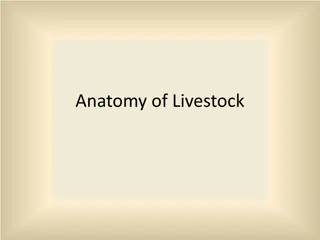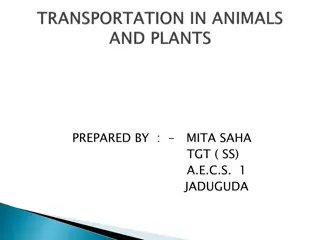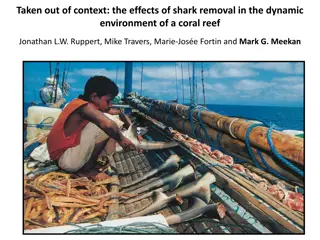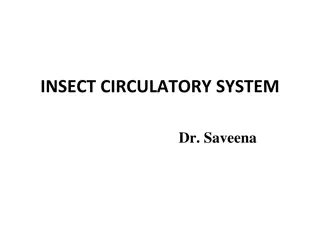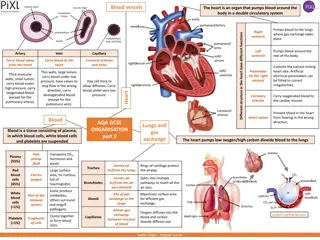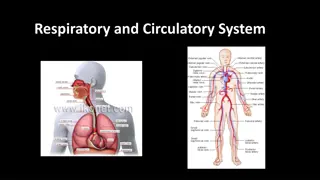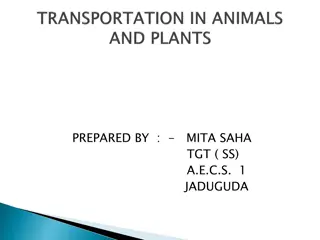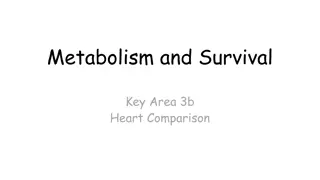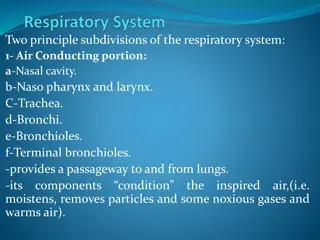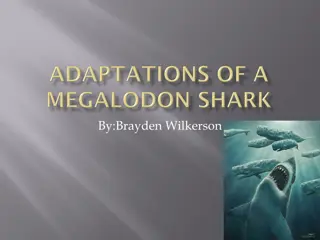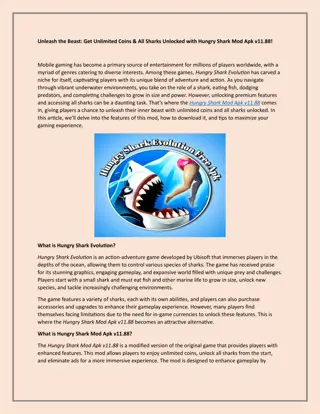Shark Circulatory, Respiratory & Reproductive Systems Overview
A detailed look into the circulation, respiration, and reproductive systems of sharks. The circulatory system of sharks includes a unique heat retention mechanism due to red muscle activity, with blood flowing from the heart to gills and back. The respiratory system involves heat generation in red muscles, resulting in increased body temperature. Additionally, male sharks have paired reproductive organs called claspers for internal fertilization. The mating process entails the transfer of sperm via claspers. Explore the fascinating physiology of sharks in this comprehensive overview.
Download Presentation

Please find below an Image/Link to download the presentation.
The content on the website is provided AS IS for your information and personal use only. It may not be sold, licensed, or shared on other websites without obtaining consent from the author.If you encounter any issues during the download, it is possible that the publisher has removed the file from their server.
You are allowed to download the files provided on this website for personal or commercial use, subject to the condition that they are used lawfully. All files are the property of their respective owners.
The content on the website is provided AS IS for your information and personal use only. It may not be sold, licensed, or shared on other websites without obtaining consent from the author.
E N D
Presentation Transcript
SHARK Circulation, Respiration and Reprodutive system Dr.M.DEIVANAYAKI
Circulatory System A shark's heart is a two-chambered S-shaped tube, small in proportion to body size. Blood flows from the heart to the gills and then to body tissues. ... Muscle-generated heat warms the blood circulating through the red muscle, which then travels back to the heart through veins.
Circulatory System A shark's heart is a two-chambered S-shaped tube, small in proportion to body size. Blood flows from the heart to the gills and then to body tissues. Fast-swimming sharks, such as great whites and makos, have a body temperature that can be quite a bit higher than the surrounding water (up to 8 C or 14.4 F higher). The heat is due to the modified circulatory system associated with the red muscle. As red muscle functions, it generates heat. Muscle-generated heat warms the blood circulating through the red muscle, which then travels back to the heart through veins. Thus, blood returning to the heart from the muscle is warmer than blood traveling from the heart to the muscle. Due to the nearness of arteries and veins, heat passes from warmer veins to cooler arteries within the shark's body, rather than dissipating to the cooler environment. This modified circulatory system retains heat in the red muscles. Sharks have a low blood pressure. The walls of the pericardium (the membranous sacs that enclose the heart) are rigid, creating a suction within the pericardium to maintain the flow of blood. To circulate blood throughout their bodies, many sharks must swim continuously.
It consists of the central nervous system; the brain and spinal cord, and the peripheral nervous system; the sense organs, cranial and spinal nerves, and their branches.
Male sharks have paired intromittent organs called claspers. ... Male sharks have claspers which are able to insert into the female during copulation and transfer sperm into her reproductive tract. Males actually have a pair of sacs running underneath their skin that they fill with seawater before they mate.
SEXUAL REPRODUCTION In these cases the fertilization is internal. At the back of the pelvic fins are the male reproductive organs called claspers, which transfer the sperm to the female. Is common that the male bites the female shark to get its interest or to immobilize it. The mating usually consists of the insertion of the clasper within the oviduct. In some species, male sharks hold firmly to the female but in other species both swim together while mating. Courtship processes are also varied, but it is common that the male bites the female shark to get its interest or to immobilize it. The females emit various types of chemicals into the water during the mating season. Since they are usually living apart from males, these chemicals attract them together. The males often bite females during the intercourse to help keep the two sharks entwined throughout the process. The females aren t harmed by this biting, although their skin shows the marks from the bites. Both the number of offspring and the length of the gestation periods vary widely according to the species. It is possible that a female of some species may have only two offspring, but some other species may have between 40 and 80. It is also possible that the gestation period lasts from 3 to 4 months or up to more than two years. Large sharks often have a gestation period longer than the small species and reproduce every two years, while the little ones have offspring each year.
LAYING EGGS (OVIPARITY) After mating, the female deposits the eggs in rocks or algae, and occasionally in some sacks known as the mermaid bags. The embryos develop inside the eggs and feed on the yolk. In total, about 30 percent of sharks are oviparous. GIVING BIRTH TO LIVE SHARKS (VIVIPARITY). The female gives birth to live offspring, just like mammals, and they are born fully developed. There is a placental link to the eggs since they feed on the placenta. Specifically, the yolk sac develops within a placenta that is attached to the wall of the uterus and gives the offspring the nutrients necessary for their growth. Examples of viviparous are hammerhead sharks (Sphyrnidae family), the bull shark (Carcharhinus leucas) and the blue shark (Prionace glauca). These species give birth to live sharks which they abandon after the delivery. Newborn sharks instinctively know how to survive alone. Shark mothers do not take care of their young. EGGS DEVELOP INSIDE THE MOTHER (OVOVIVIPARITY) Most sharks have ovoviviparous embryonic development, as the eggs hatch within the oviduct of the female although she does not provide any food directly; the young feed on the egg yolk of the yolk sac and the fluids that the walls of the oviduct secrete. When they are ready, they hatch inside the mother, and the pups born alive and fully developed. Some species practice a form of cannibalism known as oophagy, which means that they will eat the remaining eggs that have not hatched to end their development.
